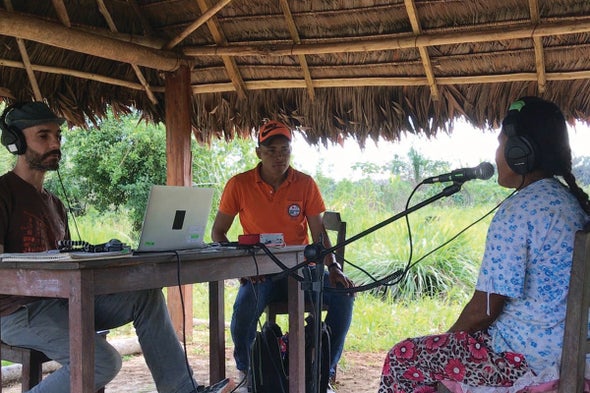(单词翻译:单击)
听力文本
This is Scientific American — 60-Second Science, I'm Susanne Bard.
Every culture around the world creates music. But what shapes our perception of music? Two candidates are the limits of the human brain and the exposure we've already had to music during our lives.
"If you only test participants with experience with Western music, then we really can't know whether these features comes from the experience or from the biological constraint."
Psychologist Nori Jacoby of the Max Planck Institute for Empirical Aesthetics. During the past few years, he and his colleagues have visited a remote area of Bolivia to investigate this question.
"And so we traveled there by taking a canoe ride or taking a Cessna plane or a couple of hours on a truck to communities that don't have running water or electricity."
The Tsimane' are an indigenous people who live in the Amazon basin.
"We specifically recruited participants from the Bolivian Amazon because these participants have relatively little exposure to Western music."
For example, octaves are a staple of Western music, but Tsimane' musical instruments don't feature them. As an acoustical phenomenon, an octave is defined as the interval in which the vibrational frequency of the bottom note is half that of the top note. They're considered the same note, an octave apart. For example, middle C...
(CLIP: Middle C tone)
... and high C.
(CLIP: High C tone)

For the study, Tsimane' participants were asked to listen to simple melodies and sing them back to the researchers. This exercise revealed that the Tsimane' don't perceive tones that are an octave apart as the same note. On the other hand, participants from the U.S. did recognize octaves—although musically trained Westerners were better at it than those with no musical training.
"And so what is exciting here is that it highlights the importance of experience and exposure on the human mind."
The research is in the journal Current Biology.
In an earlier study, Jacoby's colleague Josh McDermott and his team from M.I.T. found that the Tsimane' don't find it unpleasant to hear notes like C and F# played together.
(CLIP: C and F# notes)
But they're a dissonant combo that's particularly grating to many Western ears.
Despite the evidence that experience influences pitch perception, biology is also a factor. Jacoby says the new study also revealed that both Westerners and the Tsimane' have trouble distinguishing between really high notes above 4,000 hertz...
(CLIP: 4,000 hertz tone)
... even though human hearing goes all the way up to 20,000 hertz.
And that may be because, no matter where we're from, we hit the limits of our brains before we reach the limits of our ears.
Thanks for listening for Scientific American — 60-Second Science. I'm Susanne Bard.
参考译文
这里是科学美国人——60秒科学系列,我是苏珊娜·巴德。
世界上每种文化都创造音乐。那是什么塑造了我们对音乐的认知呢?两个可能的原因是:人类大脑的极限以及我们生活中已有的对音乐的接触。
“如果你只测试有西方音乐经验的参与者,那我们无法知道这些特征是来自经验还是来自生物学限制。”
马克斯普朗克经验美学研究所的心理学家诺瑞·雅各比说到。过去几年,他和同事走访了玻利维亚一个偏远地区,以调查这个问题。
“我们乘坐独木舟或塞斯纳飞机,或坐几个小时的卡车前往没有自来水或电力供应的社区。”
提斯曼人是生活在亚马逊盆地的土著人。
“我们特意从玻利维亚亚马逊招募了参与者,因为这些参与者较少接触西方音乐。”
例如,八度音阶是西方音乐的重要组成部分,但提斯曼人的乐器却没有八度音阶。作为一种声学现象,八度音阶指的是音程,其中底部音符的震动频率是顶部音符的一半。它们被视为相隔一个八度的同一音。例如,中央C音……
(音频剪辑:中央C音)
和高音C。
(音频剪辑:高音C)
为了研究,提斯曼参与者被要求听简单的乐曲,然后唱给研究人员听。这项实验揭示,提斯曼人并未将相隔八度的音视为同一个音。另一方面,来自美国的参与者确实识别出八度音阶——尽管受过音乐训练的西方人比没有受过训练的人更擅长识别。
“令人兴奋的是,它强调了体验和接触对人类思维的重要性。”
这项研究发表在《当代生物学》期刊上。
在早期研究中,雅各比的同事乔什·麦克德莫特和他来自麻省理工学院的团队发现,提斯曼人听C调与F调合奏时并未觉得不适。
(音频剪辑:C音和F音)
但这是一种不和谐的组合,尤其令许多西方人感到刺耳。
尽管有证据表明经验会影响音高感知,但生物学也是一个因素。雅各比表示,新研究还揭示,西方人和提斯曼人都难以区分4000赫兹以上的高音。
(音频剪辑:4000赫兹的音高)
即使人类的听力可以达到20000赫兹。
这可能是因为,无论我们来自哪里,我们在到达听力极限时会先达到大脑极限。
谢谢大家收听科学美国人——60秒科学。我是苏珊娜·巴德。
译文为可可英语翻译,未经授权请勿转载!
重点讲解
重点讲解:
1. a staple of 主要部分;重要内容;
Political reporting has become a staple of American journalism.
政治新闻已成为美国新闻报道的主要内容。
2. be better at 更擅长;
Cultures that were better at trading saw a concomitant increase in their wealth.
比较擅长贸易的文明其财富也随之增长。
3. distinguish between 区分;辨别;分清;
At what age are children able to distinguish between right and wrong?
儿童到什么年龄才能明辨是非?
4. no matter 不管…;无论…;
No matter where his business took him, he always managed to be home for Thanksgiving.
不管因生意关系去了什么地方,他总要赶回家过感恩节。


